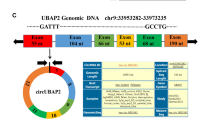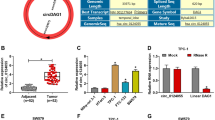Abstract
Purpose
Studies have shown that circRNA is involved in the occurrence and development of human cancers. However, it remains unclear that the contribution of circRNA in thyroid carcinoma and its role in the process of tumorigenesis.
Methods
The expression profile of circRNA-miRNA-mRNA in thyroid carcinoma was detected by RNA sequencing and verified by qRT-PCR. The characteristics of circGLIS3 were verified by RNase R and actinomycin assays, subcellular fractionation, and fluorescence in situ hybridization. The functions of circGLIS3 and AIF1L were detected by wound healing, transwell, 3D culture and Western blot. RNA Immunoprecipitation (RIP), RNA pulldown and dual-luciferase reporter assays were used to verify the target genes of circGLIS3 and downstream miRNAs. Functional rescue experiments were performed by transfecting miRNA mimics or siRNA of target genes. Finally, metastatic mouse models were used to investigate circGLIS3 function in vivo.
Results
In this study, we discovered a novel circRNA (has_circ_0007368, named as circGLIS3) by RNA sequencing. CircGLIS3 was down-regulated in thyroid carcinoma tissues and cells line, and was negatively associated with malignant clinical features of thyroid carcinoma. Functional studies found that circGLIS3 could inhibit the migration and invasion of thyroid carcinoma cells, and was related to the EMT process. Mechanistically, circGLIS3 can upregulate the expression of the AIF1L gene by acting as a miR-146b-3p sponge to inhibit the progression of thyroid carcinoma.
Conclusion
Our study identified circGLIS3 as a novel tumor suppressor in thyroid cancer, indicating the potential of circGLIS3 as a promising diagnostic and prognostic marker for thyroid cancer.







Similar content being viewed by others
Data Availability
The data in the present study is available from the corresponding author upon reasonable request.
Abbreviations
- DTC:
-
Differentiated thyroid carcinoma
- circRNAs:
-
Circular RNAs
- EMT:
-
Epithelial-mesenchymal transition
- RBPs:
-
RNA binding proteins
- PTC:
-
Papillary thyroid carcinoma
- ceRNA:
-
Competing endogenous RNA
- ATC:
-
Anaplastic thyroid carcinoma
- FBS:
-
Fetal bovine serum
- NC:
-
Negative control
- FISH:
-
Fluorescence in situ hybridization
- 3D:
-
Three-dimensional
- RIP:
-
RNA immunoprecipitation
- SD:
-
Standard deviation
- gDNA:
-
Genomic DNA
- AIF1L:
-
Allograft inflammatory factor 1 like
- IBA2:
-
Ionized calcium-binding adapter molecule 2
- AIF1:
-
Allograft inflammatory factor 1
References
Siegel, R.L., et al., Cancer Statistics, 2021. CA Cancer J Clin 71(1), 7-33 (2021)
L. Shobab, K.D. Burman, L. Wartofsky, Sex differences in differentiated thyroid Cancer. Thyroid. 32(3), 224–235 (2022)
I.C. Huang et al., Long-term outcomes of distant metastasis from differentiated thyroid carcinoma. Clin. Endocrinol. (Oxf). 76(3), 439–447 (2012)
M. Xing, Molecular pathogenesis and mechanisms of thyroid cancer. Nat. Rev. Cancer. 13(3), 184–199 (2013)
R. Liu et al., Regulation of mutant TERT by BRAF V600E/MAP kinase pathway through FOS/GABP in human cancer. Nat. Commun. 9(1), 579 (2018)
L.S. Kristensen et al., The biogenesis, biology and characterization of circular RNAs. Nat. Rev. Genet. 20(11), 675–691 (2019)
S. Memczak et al., Circular RNAs are a large class of animal RNAs with regulatory potency. Nature 495(7441), 333–338 (2013)
L.S. Kristensen et al., The emerging roles of circRNAs in cancer and oncology. Nat. Rev. Clin. Oncol. 19(3), 188–206 (2022)
Y. Liu et al., Circular RNA circGlis3 protects against islet β-cell dysfunction and apoptosis in obesity. Nat. Commun. 14(1), 351 (2023)
S. Qu et al., The emerging functions and roles of circular RNAs in cancer. Cancer Lett. 414, 301–309 (2018)
X. Peng et al., Circular RNA_0057209 Acts as ceRNA to Inhibit Thyroid Cancer Progression by Promoting the STK4-Mediated Hippo Pathway via Sponging MicroRNA-183. Oxid. Med. Cell. Longev., 9974639 (2022).
B.M. Shifman et al., Circular RNAs and thyroid cancer: closed molecules, open possibilities. Crit. Rev. Oncol. Hematol. 173, 103662 (2022)
Q. Zhang et al., Hsa_circ_0023990 promotes Tumor Growth and Glycolysis in Dedifferentiated TC via Targeting miR-485-5p/FOXM1 Axis. Endocrinology 162(12) (2021)
W. Yu et al., The combination of circRNA-UMAD1 and Galectin-3 in peripheral circulation is a co-biomarker for predicting lymph node metastasis of thyroid carcinoma. Am. J. Transl Res. 12(9), 5399–5415 (2020)
E. Anastasiadou, L.S. Jacob, F.J. Slack, Non-coding RNA networks in cancer. Nat. Rev. Cancer 18(1), 5–18 (2018)
Z. Luo, R.N.A. Circular et al., circCCDC9 acts as a mir-6792-3p sponge to suppress the progression of gastric cancer through regulating CAV1 expression. Mol. Cancer 19(1), 86 (2020)
Z. Cheng et al., circTP63 functions as a ceRNA to promote lung squamous cell carcinoma progression by upregulating FOXM1. Nat. Commun. 10(1), 3200 (2019)
X. Guo et al., Circular RNA circBFAR promotes the progression of pancreatic ductal adenocarcinoma via the miR-34b-5p/MET/Akt axis. Mol. Cancer. 19(1), 83 (2020)
H. Liu et al., circPTCH1 promotes invasion and metastasis in renal cell carcinoma via regulating miR-485-5p/MMP14 axis. Theranostics. 10(23), 10791–10807 (2020)
L. Chen et al., The bioinformatics toolbox for circRNA discovery and analysis. Brief. Bioinform. 22(2), 1706–1728 (2021)
C. Xu, J. Zhang, Mammalian circular RNAs result largely from splicing errors. Cell. Rep. 36(4), 109439 (2021)
T. Aktaş et al., DHX9 suppresses RNA processing defects originating from the Alu invasion of the human genome. Nature. 544(7648), 115–119 (2017)
L. Salmena et al., A ceRNA hypothesis: the Rosetta Stone of a hidden RNA language? Cell. 146(3), 353–358 (2011)
C.K. Chou et al., miR-146b is highly expressed in adult papillary thyroid carcinomas with high risk features including extrathyroidal invasion and the BRAF(V600E) mutation. Thyroid 20(5), 489–494 (2010)
M.V. Geraldo, A.S. Yamashita, E.T. Kimura, MicroRNA miR-146b-5p regulates signal transduction of TGF-β by repressing SMAD4 in thyroid cancer. Oncogene 31(15), 1910–1922 (2012)
X. Deng et al., MiR-146b-5p promotes metastasis and induces epithelial-mesenchymal transition in thyroid cancer by targeting ZNRF3. Cell. Physiol. Biochem. 35(1), 71–82 (2015)
C. Yu et al., MicroRNA-146b-3p promotes cell metastasis by directly targeting NF2 in human papillary thyroid Cancer. Thyroid 28(12), 1627–1641 (2018)
G. Riesco-Eizaguirre et al., The miR-146b-3p/PAX8/NIS Regulatory Circuit modulates the differentiation phenotype and function of thyroid cells during carcinogenesis. Cancer Res. 75(19), 4119–4130 (2015)
S. Hou et al., Downregulation of miR-146b-3p inhibits Proliferation and Migration and modulates the expression and location of Sodium/Iodide Symporter in dedifferentiated thyroid Cancer by potentially targeting MUC20. Front. Oncol. 10, 566365 (2020)
J.O. Schulze et al., Structural and functional characterization of human iba proteins. FEBS J. 275(18), 4627–4640 (2008)
R. Donato, S100: a multigenic family of calcium-modulated proteins of the EF-hand type with intracellular and extracellular functional roles. Int. J. Biochem. Cell. Biol. 33(7), 637–668 (2001)
M. Yasuda-Yamahara et al., AIF1L regulates actomyosin contractility and filopodial extensions in human podocytes. PLoS One 13(7), e0200487 (2018)
P. Liu et al., Absence of AIF1L contributes to cell migration and a poor prognosis of breast cancer. Onco Targets Ther. 11, 5485–5498 (2018)
Y. Zhang, S. Wang, L. Li, E.F. Hand Protein, IBA2 promotes cell proliferation in breast cancers via Transcriptional Control of Cyclin D1. Cancer Res. 76(15), 4535–4545 (2016)
Funding
This work was funded by the National Natural Science Foundation of China (No.81772850 and No.82273300) and Medical Science and Technology Research Fund of Guangdong Province (A2021127).
Author information
Authors and Affiliations
Contributions
S.C. and Y.Y. performed the experiments and drafted the manuscript; H.H. and W.H. provided experimental support; W.L. collected the clinical specimens; S.H., R.L. and Y.L. commented on the study; S.Y. and H.X. designed and supervised the study and revised the manuscript. All authors reviewed the manuscript.
Corresponding authors
Ethics declarations
Ethics approval and consent to participate
The study, which involved human samples, obtained approval from the Institutional Research Ethics Committee of Sun Yat-sen University. Animal Experiment were carried out in accordance with the National Research Council’s Guide for the Care and Use of Laboratory Animals and were conducted with the approval of the Ethics Committee of Sun Yat-sen University.
Competing interests
The authors declare no potential conflicts of interest.
Additional information
Publisher’s Note
Springer Nature remains neutral with regard to jurisdictional claims in published maps and institutional affiliations.
Electronic supplementary material
Below is the link to the electronic supplementary material.
Rights and permissions
Springer Nature or its licensor (e.g. a society or other partner) holds exclusive rights to this article under a publishing agreement with the author(s) or other rightsholder(s); author self-archiving of the accepted manuscript version of this article is solely governed by the terms of such publishing agreement and applicable law.
About this article
Cite this article
Cao, S., Yin, Y., Hu, H. et al. CircGLIS3 inhibits thyroid cancer invasion and metastasis through miR-146b-3p/AIF1L axis. Cell Oncol. 46, 1777–1789 (2023). https://doi.org/10.1007/s13402-023-00845-2
Accepted:
Published:
Issue Date:
DOI: https://doi.org/10.1007/s13402-023-00845-2




